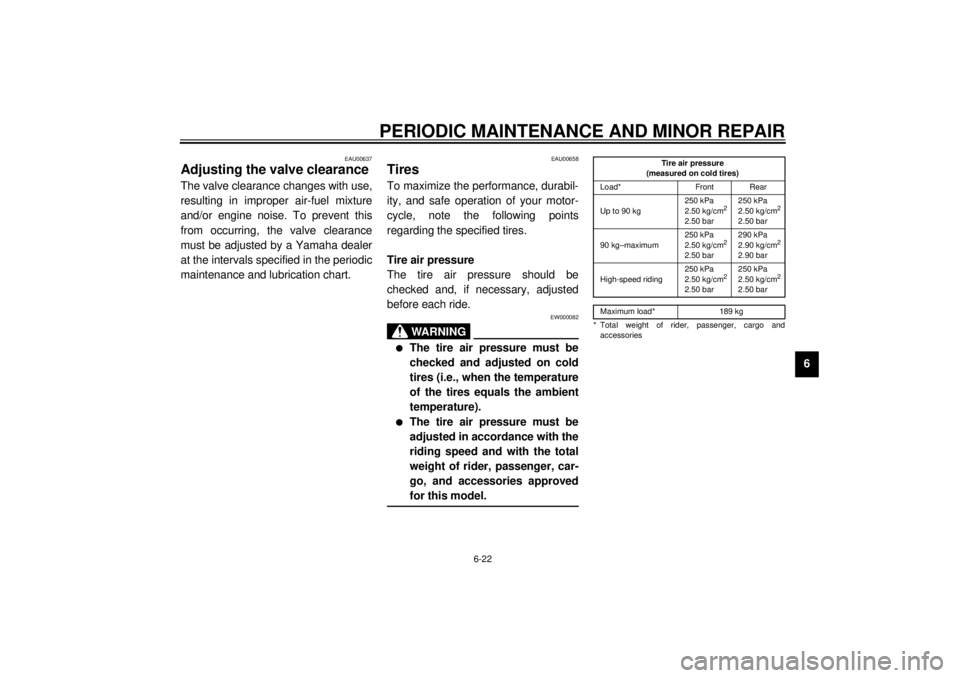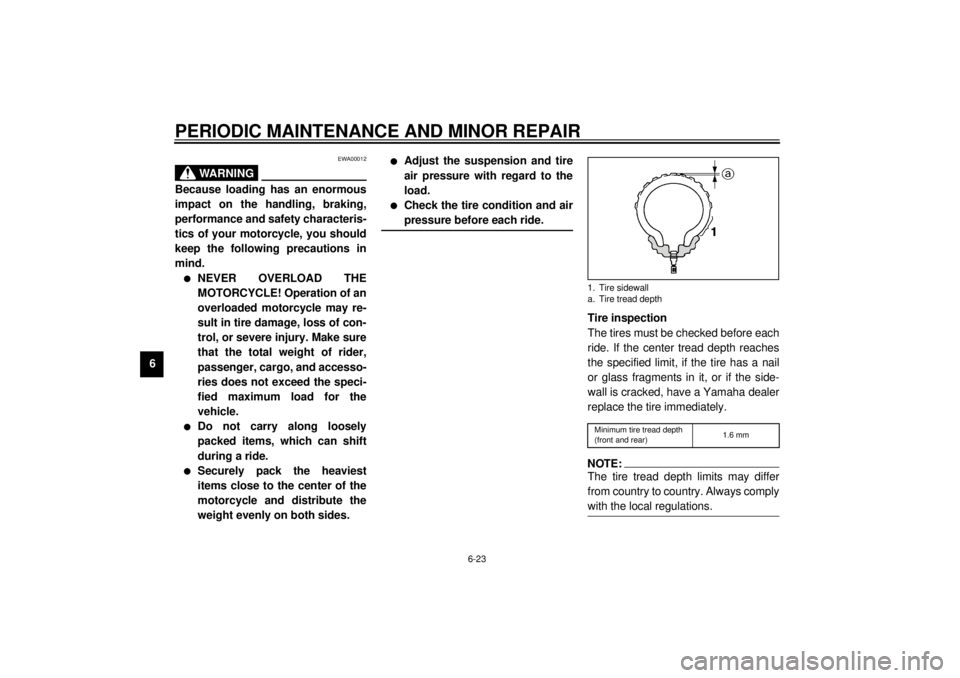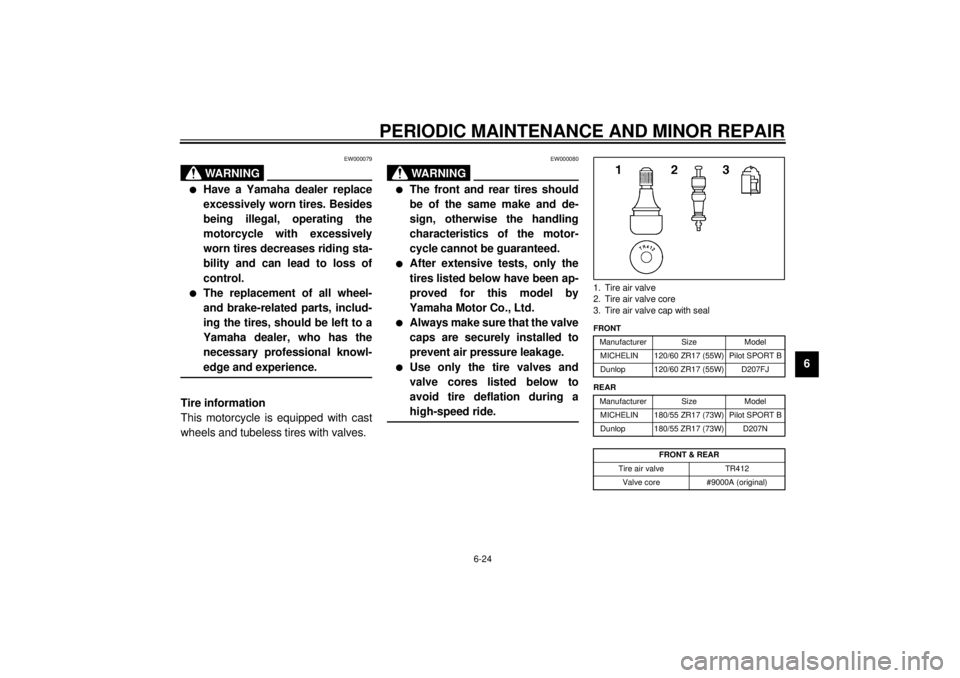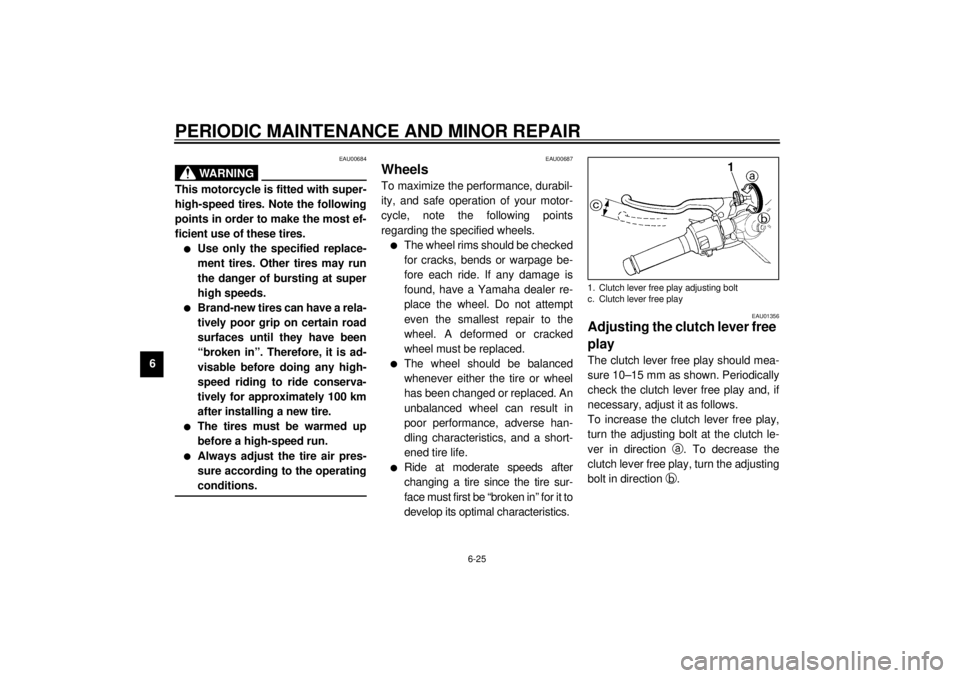YAMAHA YZF-R6 2001 Manual PDF
Manufacturer: YAMAHA, Model Year: 2001, Model line: YZF-R6, Model: YAMAHA YZF-R6 2001Pages: 118, PDF Size: 12.83 MB
Page 71 of 118

PERIODIC MAINTENANCE AND MINOR REPAIR
6-20
6
EAU01335
Air intake duct Check that the screen of the intake
duct is not blocked. Clean the screen if
necessary.
EAU00630
Adjusting the carburetors The carburetors are important parts of
the engine and require very sophisti-
cated adjustment. Therefore, most car-
buretor adjustments should be left to a
Yamaha dealer, who has the neces-
sary professional knowledge and expe-
rience. The adjustment described in
the following section, however, may be
serviced by the owner as part of routine
maintenance.
EC000095
CAUTION:@ The carburetors have been set and
extensively tested at the Yamaha
factory. Changing these settings
without sufficient technical knowl-
edge may result in poor perfor-
mance of or damage to the engine. @
1. Air intake duct
E_5mt.book Page 20 Monday, September 18, 2000 9:08 AM
Page 72 of 118

PERIODIC MAINTENANCE AND MINOR REPAIR
6-21
6
EAU00632
Adjusting the engine idling
speed The engine idling speed must be
checked and, if necessary, adjusted as
follows at the intervals specified in the
periodic maintenance and lubrication
chart.
1. Start the engine and warm it up for
several minutes at 1,000–
2,000 r/min while occasionally rev-
ving it to 4,000–5,000 r/min.NOTE:@ The engine is warm when it quickly re-
sponds to the throttle. @
2. Check the engine idling speed
and, if necessary, adjust it to spec-
ification by turning the throttle stop
screw. To increase the engine
idling speed, turn the screw in di-
rection
a. To decrease the engine
idling speed, turn the screw in
direction
b.NOTE:@ If the specified idling speed cannot be
obtained as described above, have a
Yamaha dealer make the adjustment. @
EAU00635
Adjusting the throttle cable
free play The throttle cable free play should
measure 6–8 mm at the throttle grip.
Periodically check the throttle cable
free play and, if necessary, have a
Yamaha dealer adjust it.
1. Throttle stop screw
Engine idling speed:
1,250–1,350 r/min
a. Throttle cable free play
E_5mt.book Page 21 Monday, September 18, 2000 9:08 AM
Page 73 of 118

PERIODIC MAINTENANCE AND MINOR REPAIR
6-22
6
EAU00637
Adjusting the valve clearance The valve clearance changes with use,
resulting in improper air-fuel mixture
and/or engine noise. To prevent this
from occurring, the valve clearance
must be adjusted by a Yamaha dealer
at the intervals specified in the periodic
maintenance and lubrication chart.
EAU00658
Tires To maximize the performance, durabil-
ity, and safe operation of your motor-
cycle, note the following points
regarding the specified tires.
Tire air pressure
The tire air pressure should be
checked and, if necessary, adjusted
before each ride.
EW000082
WARNING
@ l
The tire air pressure must be
checked and adjusted on cold
tires (i.e., when the temperature
of the tires equals the ambient
temperature).
l
The tire air pressure must be
adjusted in accordance with the
riding speed and with the total
weight of rider, passenger, car-
go, and accessories approved
for this model.
@
CE-01E
CE-07E
Tire air pressure
(measured on cold tires)
Load* Front Rear
Up to 90 kg250 kPa
2.50 kg/cm
2
2.50 bar250 kPa
2.50 kg/cm
2
2.50 bar
90 kg–maximum250 kPa
2.50 kg/cm
2
2.50 bar290 kPa
2.90 kg/cm
2
2.90 bar
High-speed riding250 kPa
2.50 kg/cm
2
2.50 bar250 kPa
2.50 kg/cm
2
2.50 bar
Maximum load* 189 kg
* Total weight of rider, passenger, cargo and
accessories
E_5mt.book Page 22 Monday, September 18, 2000 9:08 AM
Page 74 of 118

PERIODIC MAINTENANCE AND MINOR REPAIR
6-23
6
EWA00012
WARNING
@ Because loading has an enormous
impact on the handling, braking,
performance and safety characteris-
tics of your motorcycle, you should
keep the following precautions in
mind. l
NEVER OVERLOAD THE
MOTORCYCLE! Operation of an
overloaded motorcycle may re-
sult in tire damage, loss of con-
trol, or severe injury. Make sure
that the total weight of rider,
passenger, cargo, and accesso-
ries does not exceed the speci-
fied maximum load for the
vehicle.
l
Do not carry along loosely
packed items, which can shift
during a ride.
l
Securely pack the heaviest
items close to the center of the
motorcycle and distribute the
weight evenly on both sides.
l
Adjust the suspension and tire
air pressure with regard to the
load.
l
Check the tire condition and air
pressure before each ride.
@
Tire inspection
The tires must be checked before each
ride. If the center tread depth reaches
the specified limit, if the tire has a nail
or glass fragments in it, or if the side-
wall is cracked, have a Yamaha dealer
replace the tire immediately.CE-08ENOTE:@ The tire tread depth limits may differ
from country to country. Always comply
with the local regulations. @1. Tire sidewall
a. Tire tread depthMinimum tire tread depth
(front and rear)1.6 mm
E_5mt.book Page 23 Monday, September 18, 2000 9:08 AM
Page 75 of 118

PERIODIC MAINTENANCE AND MINOR REPAIR
6-24
6
EW000079
WARNING
@ l
Have a Yamaha dealer replace
excessively worn tires. Besides
being illegal, operating the
motorcycle with excessively
worn tires decreases riding sta-
bility and can lead to loss of
control.
l
The replacement of all wheel-
and brake-related parts, includ-
ing the tires, should be left to a
Yamaha dealer, who has the
necessary professional knowl-
edge and experience.
@Tire information
This motorcycle is equipped with cast
wheels and tubeless tires with valves.
EW000080
WARNING
@ l
The front and rear tires should
be of the same make and de-
sign, otherwise the handling
characteristics of the motor-
cycle cannot be guaranteed.
l
After extensive tests, only the
tires listed below have been ap-
proved for this model by
Yamaha Motor Co., Ltd.
l
Always make sure that the valve
caps are securely installed to
prevent air pressure leakage.
l
Use only the tire valves and
valve cores listed below to
avoid tire deflation during a
high-speed ride.
@
CE-10E
CE-14E1. Tire air valve
2. Tire air valve core
3. Tire air valve cap with sealFRONT
Manufacturer Size Model
MICHELIN 120/60 ZR17 (55W) Pilot SPORT B
Dunlop 120/60 ZR17 (55W) D207FJ
REAR
Manufacturer Size Model
MICHELIN 180/55 ZR17 (73W) Pilot SPORT B
Dunlop 180/55 ZR17 (73W) D207N
FRONT & REAR
Tire air valve TR412
Valve core #9000A (original)
E_5mt.book Page 24 Monday, September 18, 2000 9:08 AM
Page 76 of 118

PERIODIC MAINTENANCE AND MINOR REPAIR
6-25
6
EAU00684
WARNING
@ This motorcycle is fitted with super-
high-speed tires. Note the following
points in order to make the most ef-
ficient use of these tires.l
Use only the specified replace-
ment tires. Other tires may run
the danger of bursting at super
high speeds.
l
Brand-new tires can have a rela-
tively poor grip on certain road
surfaces until they have been
“broken in”. Therefore, it is ad-
visable before doing any high-
speed riding to ride conserva-
tively for approximately 100 km
after installing a new tire.
l
The tires must be warmed up
before a high-speed run.
l
Always adjust the tire air pres-
sure according to the operating
conditions.
@
EAU00687
Wheels To maximize the performance, durabil-
ity, and safe operation of your motor-
cycle, note the following points
regarding the specified wheels.l
The wheel rims should be checked
for cracks, bends or warpage be-
fore each ride. If any damage is
found, have a Yamaha dealer re-
place the wheel. Do not attempt
even the smallest repair to the
wheel. A deformed or cracked
wheel must be replaced.
l
The wheel should be balanced
whenever either the tire or wheel
has been changed or replaced. An
unbalanced wheel can result in
poor performance, adverse han-
dling characteristics, and a short-
ened tire life.
l
Ride at moderate speeds after
changing a tire since the tire sur-
face must first be “broken in” for it to
develop its optimal characteristics.
EAU01356
Adjusting the clutch lever free
play The clutch lever free play should mea-
sure 10–15 mm as shown. Periodically
check the clutch lever free play and, if
necessary, adjust it as follows.
To increase the clutch lever free play,
turn the adjusting bolt at the clutch le-
ver in direction
a. To decrease the
clutch lever free play, turn the adjusting
bolt in direction
b.1. Clutch lever free play adjusting bolt
c. Clutch lever free play
E_5mt.book Page 25 Monday, September 18, 2000 9:08 AM
Page 77 of 118

PERIODIC MAINTENANCE AND MINOR REPAIR
6-26
6
NOTE:@ If the specified clutch lever free play
cannot be obtained as described
above, proceed as follows. @1. Fully turn the adjusting bolt at the
clutch lever in direction
a to loos-
en the clutch cable.
2. Remove cowling A. (See page 6-6
for cowling removal and installa-
tion procedures.)
3. Loosen the locknut at the crank-
case.
4. To increase the clutch lever free
play, turn the adjusting nut in di-
rection
a. To decrease the clutch
lever free play, turn the adjusting
nut in direction
b.
5. Tighten the locknut.
6. Install the cowling.
1. Locknut
2. Clutch lever free play adjusting nut
E_5mt.book Page 26 Monday, September 18, 2000 9:08 AM
Page 78 of 118

PERIODIC MAINTENANCE AND MINOR REPAIR
6-27
6
EAU01357
Adjusting the brake pedal
position The top of the brake pedal should be
positioned approximately 7–11 mm be-
low the bottom of the footrest bracket
as shown. Periodically check the brake
pedal position and, if necessary, have
a Yamaha dealer adjust it.
EW000109
WARNING
_ A soft or spongy feeling in the brake
pedal can indicate the presence of
air in the hydraulic system. If there
is air in the hydraulic system, have a
Yamaha dealer bleed the system be-
fore operating the motorcycle. Air in
the hydraulic system will diminish
the braking performance, which
may result in loss of control and an
accident. _
EAU00713
Adjusting the rear brake light
switch The rear brake light switch, which is ac-
tivated by the brake pedal, is properly
adjusted when the brake light comes
on just before braking takes effect. If
necessary, adjust the brake light switch
as follows.
Turn the adjusting nut while holding the
rear brake light switch in place. To
make the brake light come on earlier,
turn the adjusting nut in direction
a. To
make the brake light come on later,
turn the adjusting nut in direction
b.
a. Distance between brake pedal and footrest
bracket
1. Rear brake light switch
2. Rear brake light switch adjusting nut
E_5mt_Periodic.fm Page 27 Tuesday, December 12, 2000 5:49 PM
Page 79 of 118

PERIODIC MAINTENANCE AND MINOR REPAIR
6-28
6
EAU00721
Checking the front and rear
brake pads The front and rear brake pads must be
checked for wear at the intervals spec-
ified in the periodic maintenance and
lubrication chart.
EAU00725
Front brake pads
Each front brake pad is provided with a
wear indicator groove, which allows
you to check the brake pad wear with-
out having to disassemble the brake.
To check the brake pad wear, check
the wear indicator groove. If a brake
pad has worn to the point that the wear
indicator groove has almost disap-
peared, have a Yamaha dealer replace
the brake pads as a set.
EAU01641
Rear brake pads
Each rear brake pad is provided with a
wear indicator groove, which allows
you to check the brake pad wear with-
out having to disassemble the brake.
Check the brake pad wear as follows.
1. Remove the rear brake caliper by
removing the bolt, and then tilt the
caliper forward to inspect the wear
indicator groove. If a brake pad
has worn to the point that the wear
indicator groove has almost disap-
peared, have a Yamaha dealer re-
place the brake pads as a set.
1. Front brake pad wear indicator grooveFront
1. Bolt
2. Rear brake caliperRear
E_5mt.book Page 28 Monday, September 18, 2000 9:08 AM
Page 80 of 118

PERIODIC MAINTENANCE AND MINOR REPAIR
6-29
62. Install the brake caliper by install-
ing the bolt, then tightening it to the
specified torque.
EAU03776
Checking the brake fluid level Insufficient brake fluid may allow air to
enter the brake system, possibly caus-
ing it to become ineffective.
Before riding, check that the brake fluid
is above the minimum level mark and
replenish if necessary. A low brake flu-
id level may indicate worn brake pads
and/or brake system leakage. If the
brake level is low, be sure to check the
brake pads for wear and the brake sys-
tem for leakage.Observe these precautions:
l
When checking the fluid level,
make sure that the top of the brake
fluid reservoir is level.
l
Use only the recommended quali-
ty brake fluid, otherwise the rubber
seals may deteriorate, causing
leakage and poor braking perfor-
mance.
l
Refill with the same type of brake
fluid. Mixing fluids may result in a
harmful chemical reaction and
lead to poor braking performance.
1. Rear brake pad wear indicator grooveTightening torque:
Brake caliper bolt:
40 Nm (4.0 m·kg)Rear
1. Front brake fluid reservoir
2. Minimum level markFront
1. Rear brake fluid reservoir
2. Minimum level mark
Recommended brake fluid: DOT 4Rear
E_5mt.book Page 29 Monday, September 18, 2000 9:08 AM